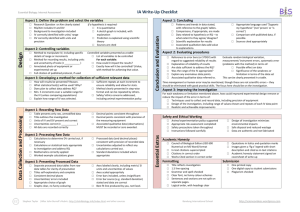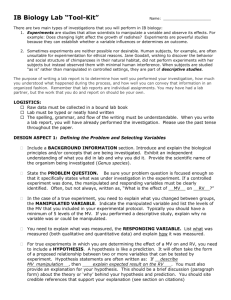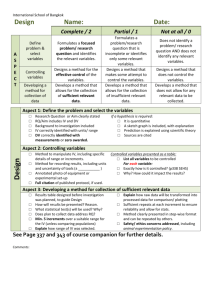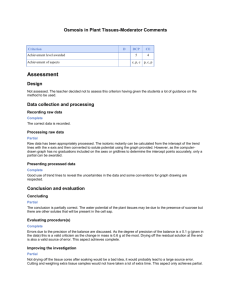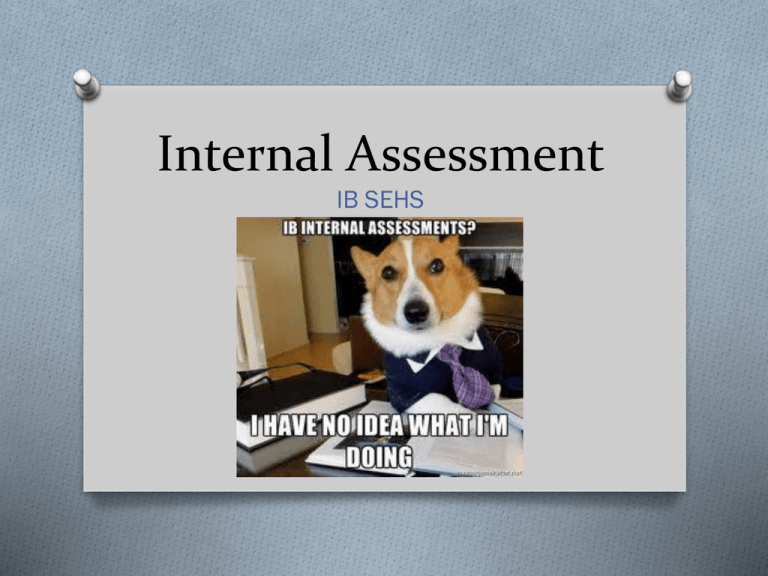
Internal Assessment
IB SEHS
Title Page
O Provides key information about YOU and
YOUR IA
O Should include:
O Name
O Candidate number (provided later)
O Date
O Research question/problem
What is the effect of one’s peer group in
selecting dietary preferences?
John Jones
1234
5/25/14
DESIGN (D)
O You are given an open-ended question to
investigate
O Investigate factors affecting the range of
movement of joints.
O You must generate your own focused
problem or specific research question.
O CHOOSE AN AREA YOU ARE INTERESTED IN!!
O Topic: Fitness
O Design an investigation on variations in the
fitness levels of individuals
O Topic: Practice
O Does practice make perfect?
O Topic: Respiratory system
O Design an investigation to characterize the
cardiovascular response to various stimuli
i. Aspect 1: defining the problem and
selecting variables
O Research Question
O Make it clear and focused and it MUST state
the dependable (measured) and the
independent (changed) variables.
O Include measurements e.g. beats per minute
(bpm)
O List all the relevant controlled variables (can
be expected to affect the outcome) along
with confounding variables (variables that
need to be monitored)
Research Question:
After a standardized exercise test, is the rate at which heart rate (bpm)
returns to the pre-exercise level different for trained and untrained
individuals?
Independent variable:
Trained athletes and untrained athletes.
Dependent variable:
Heart rate measured in beats per minute (+/- 6 bpm)
Controlled variables:
Temperature, age of participants, position/posture of participants after
exercise, measurement of heart rate, types of exercise.
Confounding variables:
Difference in hydration status, energy levels, arousal levels, weather
conditions.
Stating a hypothesis is no longer necessary BUT is a good practice.
Order of IA so far:
Title page
General Aim (re-stating the teacher prompt)
Research Question
Hypothesis
Background Information (includes literature sources and
provide valuable background info.
along with your inspiration for this
line of inquiry)
Independent variable
Dependent variable
Controlled variable
ii. Aspect 2: controlling variables
O You must give clear descriptions of how you
will control variables to ensure that only the
independent variable changes.
O You could set this
out as a table:
Variable
How it is controlled?
Why?
Feedback
No feedback from the test
conductor or observers.
This ensures
consistency and no
external factors will
affect the results.
Sample:
Age, sex,
number
20 females selected from a
pool of 50 experienced players
Results can be
generalized and
trends can be found
for this sample if they
are randomly
selected.
Type of
serve
Kick serve.
Results can be more
reliable if all the
participants are using
the same type of
serve.
• Participants in your investigation must be described with justification
for your sampling method (random, opportunity, self-selected)
• Write a clear NUMBERED method that will allow someone who does
not know what you are doing to follow your experiment-imagine it is a
recipe.
• Document how ethical guidelines were followed and explain hoe the
briefing and debriefing were carried out. A copy of the consent form
should be included in the appendices.
iii. Aspect 3: developing a method for
collecting data
O You need 3-5 repeats/trials for each
variable (e.g. temperature)
O A minimum of 5 subjects is also needed to
undertake further statistical analysis such
as standard deviation
Order of IA so far:
Title page
General Aim
Research Question
Hypothesis
Background Information
Independent variable
Dependent variable
Controlled variable
List of ALL apparatus/equipment to be used
Method of controlling the controlled variables
Diagram/picture of setup (labeled)
Method
DATA COLLECTION AND
PROCESSING (DCP)
i.
Aspect 1: recording raw
data
The numeric raw data you collected (not
averaged) must enable you to answer
the research question and enable you
to carry out basic processing along with
statistical analysis.
O Data should be recorded with a standardized
predetermined degree of precision e.g. to within
one decimal place such as 5.5 cm, 8.5 cm etc.
O Appropriate raw quantitative data could consist
of the heart rate readings, time elapsed after
finishing exercise, heart rate of the participant
before exercise and room temperature
O You are encouraged to gather qualitative
data and analyze it
O Such data would be characteristics of the
participant (age, gender, athletic history) or
resting position/posture
O Data may be gathered as a class in order to
have sufficient data to carry out significant
processing and the determination of
uncertainties HOWEVER you must clearly
present your own data
Precision of Data
O All headings/columns in data tables are
required to have an accompanying
uncertainty figure (+/– figure)
O The error is usually +/- one half of the
smallest unit that can be measured
O You may want to include human systematic
error (when using a stop watch)rather than
mechanical error…..seconds vs centimeters
Tips for Data Collection and
Using Tables
O Table titles should be descriptive and
include both the independent (changed) and
the dependent variable (measured) and may
start with the words: “Table showing the
effect of….”
O Try to fit all your data into one single table
O Ensure the table headers are descriptive for
example “Temperature of room 1” is much
better than “Temperature”
O Every header requires appropriate units
along with the error margin
O All decimal places in a column must be
consistent
O In your data table, repeats should be called
“Trial 1” and “Trial 2”
ii. Aspect 2: processing
raw data
O Data processing involves combining and manipulating
raw data and transforming umbers into a form suitable
for presentation be it graphical, written or verbal
O Common ways to process data:
O
O
O
O
O
O
O
O
Adding, subtracting
Squaring, dividing
Mean
Percentage of the whole
Percentage increase
Rate
Standard deviation
Statistical tests
iii. Aspect 3: presenting
processed data
O GRAPH IT!
O You are expected to decide upon a suitable presentation
format for your processed data
O Ways to present data
O
O
O
O
O
O
O
O
O
Scatter plot
Bar graphs
Pie charts
Histogram
Kite diagrams
Spreadsheet
Tables
Charts
Flow diagram
Preparing your Graph
O Title your graph in the same way as your
O
O
O
O
data tables
Graphs need to have appropriate scales,
labeled axes with units and accurately
plotted data points with a suitable best-fit
line or curve
Dependent variable, y-axis
Independent variable, x-axis
Reference any software used
CONCLUSION AND
EVALUATION
O i. Aspect 1: concluding
O Common mistake; students describe their
results with out explaining them
O Must include data from your results to back
up your findings and refer to the appropriate
statistical test to discuss the significance of
the data
O Good format:
O Discuss: trends in your data
O Refer to your graphs by name and state what
trends or patterns can be seen if any. Do not
imagine patterns if there are none!
O Compare: you are supposed to know
something about the topic, so now is the time
to bring in external information, usually from
textbooks or peer-reviewed journals
O Explain your data by comparing the literature
value. Do not say that your results prove an
explanation; say that they support an
explanation. REFERENCE literature
O If your results are unexpected or show no
pattern
O It is fine to state your data is inconclusive
but attempt to suggest why this may be
O Negative results that show no correlation
when you had hoped to find one are very
acceptable
O Don’t bend your data to fit what you think
should happen
O Ii. Aspect 2: evaluating procedure(s) and
Aspect 3: improving the investigation
O This can be presented as a table with 3
columns
Weaknesses
The use of thigh circumference as a
measurement of leg muscle is subjective as
a high value may be due to fat instead of
muscle. Some participants aalso have
longer bones, and thus a measurement of
the circumference 10cm above the knee
may not be where the circumference is the
larges.t
Significance of weakness
This is quite a significant
source of error as the
investigation and leg power
relies on leg muscle and not
fat, and thus delimits our
findings.
Suggest Improvement
Instead of using thigh circumference in
comparison to leg power, weight could
be used. Measuring the thigh
circumference halfway up the
participant's thigh could eliminate the
problem of varying bone lengths.
O Describe at least three major shortcomings
O Try not include minor mistakes
O Difficulties arising during the project
O Make notes of problems as you encounter
them
O Before you write your evaluation, list all the
problems you came across and consider ways
in which you could eliminate them
O Prioritize them
O Essentially you are looking to ensure you
have carried out a fair test, that is, the only
variable you have changed is the
independent variable.
O Example: it is not methodological error to
“misread non-digital scales” but it is an error
if you fail to use the same scales for all your
measurements as other scales may be
calibrated differently
When evaluating procedures
you must comment on:
O Design
O Performance of procedure
O Method
O Equipment
O Precision and accuracy of measurement
O Quality and reliability of data
O Management of time
Appendices
O Copies of additional information
O Materials use
O Standardized test instructions
O Debriefing notes
O Informed consent letters
O Each appendix should be numbered and
have an appropriate title
O Appendix 1: Nomo gram to measure leg
power
All Components of IA
O Method of controlling the
O
O
O
O
O
O
O
O
O
Title page
General Aim
Research Question
Hypothesis
Background Information
Independent variable
Dependent variable
Controlled variable
List of ALL
apparatus/equipment to
be used
O
O
O
O
O
O
O
O
controlled variables
Diagram/picture of setup
(labeled)
Method
Recording of raw data
(table)
Processing raw data
(statistical analysis)
Presentation of processed
data (table or graph)
Conclusion
Evaluation
Appendices
Group 4 Project (10 hrs)
O This a collaborative activity where students
from different group 4 subjects or schools
work together to investigate a scientific or
technological topic
Project Should Address….
O Aim 7 requires you to develop and apply
information and communication technology
skills in the study of science
O Aim 8 relates to raising awareness of the moral,
ethical, social, economic, and environmental
implications of using science and technology
O Aim 10 demands that you develop an
understanding of the relationships between
scientific disciplines and the overarching nature
of the scientific method
O The emphasis is on interdisciplinary
cooperation and the process involved in
investigation, rather than the products of
such investigation
Personal Skills
O Worth a total of 6 points out of 48 for your IA
O Graded on your involvement, your ability to
work as a team and self-reflection
Planning
O 1st planning meeting
O Elect a chair and secretary for your team
O Chair will run the meeting and make sure
everyone gets a chance to express their views
O Secretary should ensure that they have email
addresses for every student on the team
Documentation
O Types of materials collected:
O Text
O Pictures
O Graphs
O Video
O Store the information on a group blog
O Make sure all team members and the
instructor have access to the blog
O All members should regularly contribute to
the blog
O Will be used to help determine a final
assessment of your personal skills
O Also during 1st meeting
O Discuss as a group a way to develop a project
which can be completed in the time allowed.
O Topics are often broad
O Follow the scientific method……
O During 2nd meeting:
O Refine the project question and develop the
investigation
O If these tasks have already been completed,
begin the action phase
Types of Projects
O Designing and carrying out a laboratory
investigation or fieldwork
O Carrying out a comparative study
(experimental or otherwise) in collaboration
with another school
O Designing and using a model or simulation
O Contributing to a long term project by the school
O Collating, manipulating and analyzing data form
other sources, such as scientific journals,
environmental organizations, science and
technology industries and government reports
Action Phase
O Test the hypothesis experimentally,
collecting and analyzing data and preparing
your presentation
O All members of the team should be
participating
O Keep the experiment simple
O Keep contributing to the blog
Evaluation/Presentation
O Presentation can be:
O Keynote speakers
O PowerPoint
O Prezi
O Video
O Share your findings, along with success and
failures
O Keep in mind the collaborative
effort of your team!!


